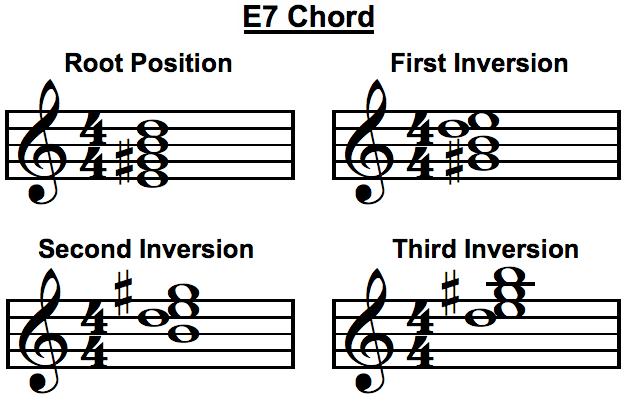he E7 chord is an altered version of the E Major Chord. It has the same notes as the E major chord with one additional note.
With the addition of this note, it creates a chord that has a lot of unique sounds and voicings. With the structure of this chord being the same as the original E major chord, it makes playing and building this chord quite simple.
There are multiple fingerings and inversions for this chord making it a little more difficult to play then a major chord. Once you learn the formula and fingering for it you won’t have any trouble.
What is an E7 Chord?
E7 is made up of four notes. Three of the notes are from the E Major Chord. E major consists of the first, third, and fifth notes in the major scale.
These notes areE, G#, and B
Check out my lessons onMajor Chordsto for easy instructions on how to build major chords.
There is one additional note that is to be added to make the E7. This is what is known as the Dominant Seventh.
This chord is made by playing an major E chord, and adding the dominant 7 note to either the top of the chord or the bottom.
How to Make an E Dominant Seven Chord
Seventh chords can be a little confusing because there are two types of seventh chords. TheMajor Seventhand theDominant Seventh.
An E Major Seventh would be written asEM7,while the Dominant Seven would be written asE7.
The difference between these two chords is whether or not the seventh note is altered or left alone.
In the EM7 chord, you play the E major chord, plus the seventh note in the scale. This would give you the notesE, G#, B, and D#.The D# has not been altered at all when making this chord.

In an E7 chord you have to alter the seventh note in the scale. Instead of using the D# that is in the E major scale, you have to use what is called the dominant seventh, or minor major seventh.
This means that you find the seventh note in the scale, which in this case would be D#, and make it a minor.
Making a note minor, means to move it onehalf-stepto the left.
Instead of using the D#, you must move it one note to the left, which would be a D natural. So the notes in an E7 chord areE, G#, B, and D.
Take a look at the image to see how the Dominant Seventh is derived.

Quick Tip!
To make an E7 chord, make an E Major chord. Then add a flat 7!
Formula
The formula for this chord is similar to a major chord. We use the same notes as we would for a major chord just add the dominant seventh.
The formula would look like this:I – III – V – bVII
Fingering and inversions
Since there are four notes in the E7 chord, there are four possibleinversions.Each inversion has its own uniquefingering.This helps make playing the chord easier, and allows easy access to other notes while playing the chord.

Take a look at the image to see the fingering for each of the four inversions.
Root Position
The root position is made up of the first, second, third, and fifth fingers. This is the most common of the four inversions. Play the E with the first finger, G# with the second finger, B with the third finger, and D with the fifth finger.
First Inversion
To play the first inversion, take the E from the bottom of the chord, and move it to the top of the chord. Start with the first finger on G#, second on B, fourth on D, and fifth on E.Second Inversion
The second inversion starts on a B. Use the first finger on B, second finger on D, third finger on E, and fifth finger on G#.Third Inversion
The last, and final inversion, starts on D with the first finger. Play an E with the second finger, G# with the fourth finger, and B with the fifth finger.
If you haven’t already noticed, these inversion are built by taking the lowest note in the previous chord and moving to the top of the chord. Check out this page for more info onpiano chord inversions.Sheet Music
Here is a chart showing the four inversions of the E7 chord on sheet music. If you look at each inversion, you will see that there is one sharp in the E Dominant 7 chord.
There are four notes in each of the four inversions with a G sharp in each of them.

Study this chart and memorize the inversions of the E7 chord so you can easily pick it out in a piece of sheet music.
The E7 chord, also known as the E Dominant chord is an easy and very common chord used in today’s contemporary music. Remember the notesE, G#, B, and Dto make this chord.
It’s also important to remember the formula ofI – III – V- bVII.This formula can help you find a Dominant Seventh chord on the spot.
Need more help learning chords? Learn almost every chord you’ll ever need with ourPiano Chord Encyclopedia.
Go FromE7 ChordBack toPiano Chords
Back toHome Page
